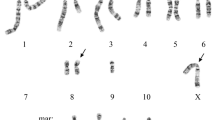Abstract
CHO-UV-1 is a mutant of the Chinese hamster cell CHO-K1 hypersensitive to killing by ultraviolet light but with normal resistance to X-ray. It is also hypersensitive to killing by ethyl methane sulfonate. Hybrid clones formed by fusing UV-1 and Chinese hamster lung cells display the normal ultraviolet resistance of the latter. The sensitive phenotype behaves, therefore, in a genetically recessive manner. Ultraviolet sensitivity of UV-1 is not associated with a deficiency in excision repair. Alkaline sucrose gradient sedimentation analysis of nascent DNA from ultraviolet-irradiated cells reveals that UV-1 is, however, markedly deficient in postreplication recovery. Further, UV-1 has a lower rate of induced mutation to 6-thioguanine resistance than does the parental cell when treated with ultraviolet light or ethyl methane sulfonate. These results suggest that the phenotype of UV-1 is due to a mutation in a form of postreplication recovery which in normal cells is error prone.
Similar content being viewed by others
Literature cited
Witkin, E.M. (1976).Bacteriol. Rev. 40:869–907.
Setlow, R.B., and Carrier, W.L. (1964).Proc. Natl. Acad. Sci. U.S.A. 51:226–231.
Bridges, B.A., and Munson, R.J. (1966).Biochem. Biophys. Res. Commun. 22:268–273.
Paterson, M.C., Smith, B.P., Lohman, P.H.M., Anderson, A.K., and Fishman, L. (1976).Nature 260:444–447.
Paterson, M., Smith, B., Knight, P., and Anderson, A. (1977). InResearch in Photobiology, (ed.) Castellani, A. (Plenum Publishing, New York), pp. 207–218.
Sasaki, M.S. (1978). InDNA Repair Mechanisms, (eds.) Hanawalt, P.C., Friedberg, E.C., and Fox, C.F. (Academic Press, New York), pp. 675–684.
Fujiwara, Y., Tatsumi, M., and Sasaki, M.S. (1977).J. Mol. Biol. 113:635–649.
Cleaver, J.E. (1968).Nature 218:652–656.
Cleaver, J.E. (1978). InMetabolic Basis of Inherited Disease, 4th ed., (eds.) Stanbury, J.B., Wyngaarden, J.B., and Frederickson, D.S. (McGraw-Hill, New York), pp. 1072–1095.
Lehman, A.R., Kirk-Bell, S., Arlett, C.F., Paterson, M.C., Lohman, P.H.M., de WeerdKastelein, E.A., and Bootsma, D. (1975).Proc. Natl. Acad. Sci. U.S.A. 72:219–223.
German, J. (1972).Progr. Med. Genet. 8:61–101.
Maher, V.M., and McCormick, J.J. (1976). InBiology of Radiation Carcinogenesis, (eds.) Yuhas, J.M., Tennant, R.W., and Regan, J.D. (Raven Press, New York), pp. 129–145.
Maher, V.M., Ouellette, L.M., Curren, R.D., and McCormick, J.J. (1976).Nature 261:593–595.
Rosenstein, B., and Ohlsson-Wilhelm, B.M. (1979).Somat. Cell Genet. 5:117–128.
Kuroki, T., and Miyashita, S.Y. (1977).J. Cell. Physiol. 90:79–90.
Sato, K., and Hieda, N. (1979).Int. J. Radiat. Biol. 35:83–87.
Schultz, R., Chang, C.C., and Trosko, J. (1978).Proc. Am. Assoc. Cancer Res. Am. Soc. Clin. Oncol. 19:83–87.
Todd, P.W., and Hellewell, A.B. (1969).Mutat. Res. 7:129–132.
Sinclair, W.K. (1964).Radiat. Res. 21:584–611.
Stamato, T.D., and Waldren, C.A. (1977).Somat. Cell Genet. 3:431–440.
Busch, D.B., Cleaver, J.E., and Glaser, D.A. (1980).Somat. Cell Genet. 6:407–418.
Thompson, L.H., Rubin, J.S., Cleaver, J.E., Whitmore, G.F., and Brookman, K. (1980).Somat. Cell Genet. 6:391–405.
Shiomi, T., and Sato, K. (1979).Somat. Cell Genet. 5:193–201.
Isomura, K., Nikaido, O., Horikawa, M., and Sugahara, T. (1973).Radiat. Res. 53:143–152.
Baker, R.M., Van Voorhis, W.C., and Spencer, L.A. (1976).Proc. Natl. Acad. Sci. U.S.A. 64:5249–5253.
Kao, F.T., Johnson, R.T., and Puck, T.T. (1969).Science 164:312–314.
Kao, F.T., Chasin, L., and Puck, T.T. (1969).Proc. Natl. Acad. Sci. U.S.A. 64:1284–1291.
Kao, F.T., and Puck, T.T. (1972).J. Cell. Physiol. 80:41–50.
Kao, F.T., and Puck, T.T. (1969).Proc. Natl. Acad. Sci. U.S.A. 60:1275–1281.
Ham, R.G. (1965).Proc. Natl. Acad. Sci. U.S.A. 53:288–293.
Kao, F.T., and Puck, T.T. (1967).Genetics 55:513–524.
Lee, H.H., and Puck, T.T. (1960).Radiat. Res. 12:340–348.
Kao, F.T., and Puck, T.T. (1969).J. Cell. Physiol. 74:245–258.
O'Neill, P., Couch, D.B., Machanoff, R., San Sebastian, J.R., Brimer, P.A., and Hsie, A.W. (1977).Mutat. Res. 45:103–109.
Collins, A.R.S. (1977).Biochim. Biophys. Acta 478:461–473.
Ahnstrom, G., and Edvardsson, K.A. (1974).Int. J. Radiat. Biol. 26:493–497.
Collins, A.R.S., and Johnson, R.T. (1979).J. Cell. Physiol. 99:125–138.
Tobey, R.A., Anderson, E.C., and Pedersen, D.F. (1967).J. Cell. Physiol. 70:63–68.
Carrier, W.L., and Setlow, R.B. (1971).Ann. Biochem. 43:427–432.
Kraemer, K. (1977). InDNA Repair Processes, (eds.) Nichols, W.W., and Murphy, D.G., (Symposia Specialists, Miami), pp. 37–71.
Regan, J.D., and Setlow, R.B. (1976). InBiology of Radiation Carcinogenesis, (eds.) Yuhas, J.M., Tennant, R.W., and Regan, J.D. (Raven Press, New York), pp. 103–113.
Collins, A.R.S., Downes, C.S., and Johnson, R.T. (1980).J. Cell Physiol. 103:179–191.
Collins, A.R.S., and Johnson, R.T. (1981). InDNA Repair: A Laboratory Manual of Research Procedures. (eds.) Friedberg, E.C., and Hanawalt, P.C. (Marcel Dekker, New York), pp. 341–360.
Walters, R.A., Tobey, R.A., and Ratliff, R.L. (1973).Biochim. Biophys. Acta 319:336–347.
Lohman, P.H.M., Paterson, M.C., Zelle, B., and Reynolds, R.J. (1977).Mutat. Res. 46:138–139.
Lehman, A.R., and Kirk-Bell, S. (1972).Eur. J. Biochem. 31:438–445.
Park, S.D., and Cleaver, J.E. (1979).Proc. Natl. Acad. Sci. U.S.A. 76:3927–3931.
Hanawalt, P.C., Cooper, P.K., Ganesan, A.K., and Smith, C.A. (1979).Annu. Rev. Biochem. 48:783–836.
Author information
Authors and Affiliations
Rights and permissions
About this article
Cite this article
Stamato, T.D., Hinkle, L., Collins, A.R.S. et al. Chinese hamster ovary mutant UV-1 is hypomutable and defective in a postreplication recovery process. Somat Cell Mol Genet 7, 307–320 (1981). https://doi.org/10.1007/BF01538856
Received:
Revised:
Issue Date:
DOI: https://doi.org/10.1007/BF01538856




